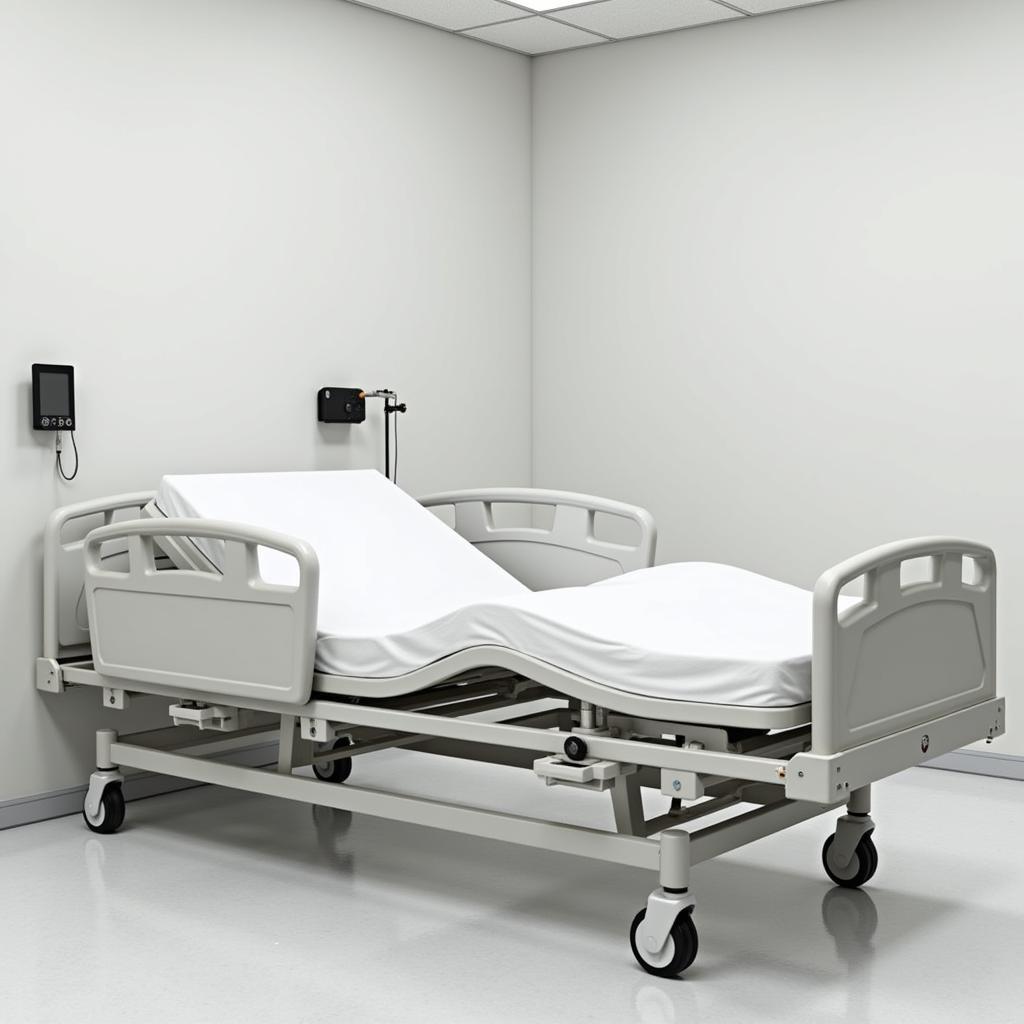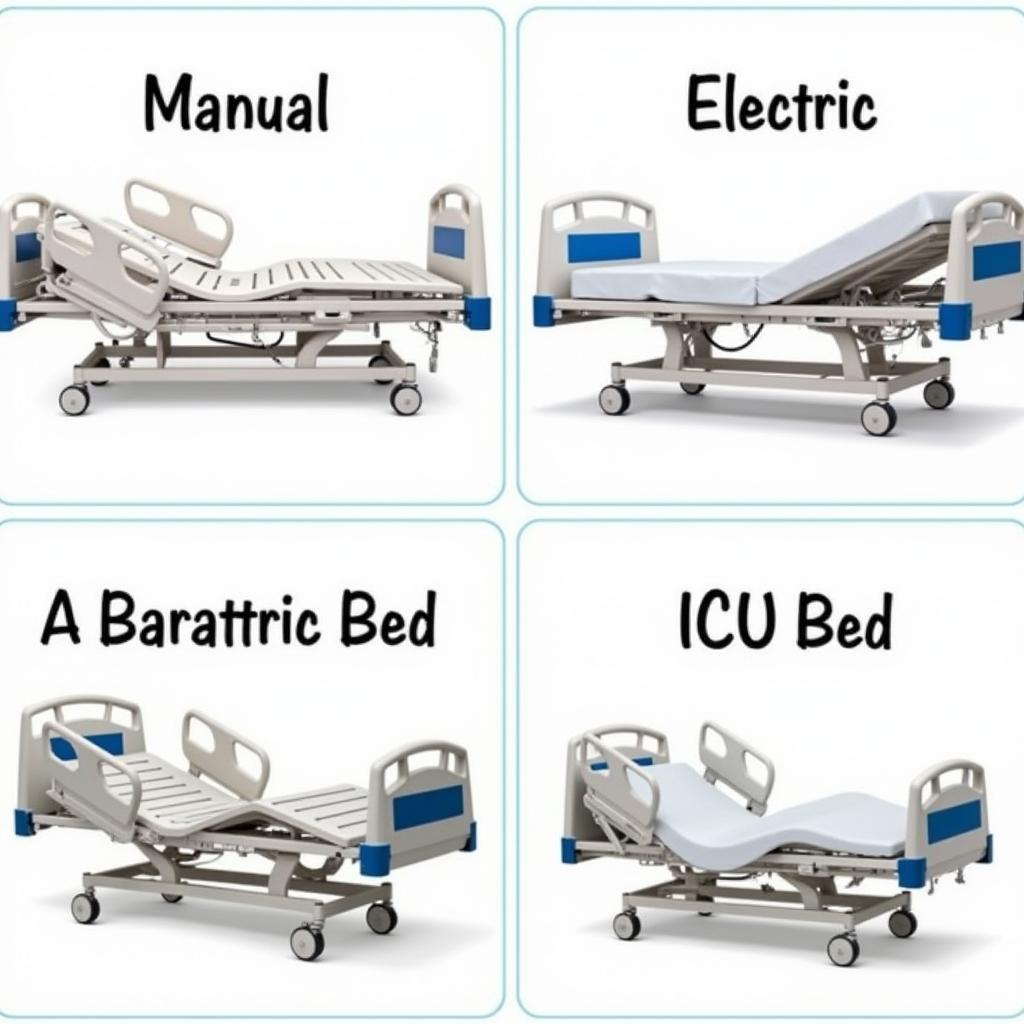Understanding the different Types Of Hospital Beds is crucial for both healthcare professionals and individuals seeking the best care for themselves or loved ones. This guide will explore the various types of hospital beds available, highlighting their features, benefits, and ideal uses.
Choosing the right hospital bed can significantly impact patient comfort, recovery, and overall well-being. Whether you’re a medical professional outfitting a new facility or researching options for home care, this guide will provide you with valuable insights. For those considering home care, you may find our article on how to get a hospital bed at home particularly helpful.
Manual Hospital Beds: Providing Basic Functionality
Manual hospital beds are the most basic type, operated entirely by hand cranks. These cranks control the height of the bed, the position of the head and foot sections, and sometimes the side rails. While they lack the advanced features of electric beds, manual beds are cost-effective and reliable. They are often suitable for patients who require minimal position adjustments.
Standard Manual Beds
These beds offer basic functionality and are commonly found in hospitals and other healthcare facilities. They typically feature adjustable head and foot sections, and side rails for patient safety.
Semi-Electric Beds
Semi-electric beds offer a blend of manual and electric controls. The height adjustment is typically manual, while the head and foot sections are electrically controlled. This provides a degree of convenience for patients with limited mobility.
Electric Hospital Beds: Enhanced Comfort and Control
Electric hospital beds offer greater convenience and control, allowing patients to adjust their position with ease using a handheld control. These beds are ideal for patients with limited mobility or those recovering from surgery. You may want to check out hospital recliner chair with wheels for additional comfort options.
Fully Electric Beds
These beds offer complete electric control over all adjustable features, including height, head and foot sections, and side rails. They often come with additional features such as Trendelenburg and reverse Trendelenburg positioning, which can aid in certain medical procedures and improve circulation.
Low Beds
Low beds are designed to minimize the risk of falls for patients who are at high risk. They can be either manual or electric and often feature extra safety features like padded side rails.
Bariatric Beds
Bariatric beds are specifically designed for heavier patients, with a higher weight capacity and reinforced frames for enhanced stability. These beds are essential for ensuring the safety and comfort of bariatric patients.
 Electric Hospital Bed with Handheld Control
Electric Hospital Bed with Handheld Control
Specialized Hospital Beds: Addressing Specific Needs
Specialized hospital beds cater to specific medical conditions and patient needs. These beds often incorporate advanced features to provide optimal care and support. If you are looking for specialized equipment, exploring hospital auctions might be a beneficial option.
ICU Beds
ICU beds are designed for intensive care units and feature advanced monitoring and life support capabilities. They typically include integrated scales, IV poles, and other specialized equipment.
Birthing Beds (LDR Beds)
Birthing beds, also known as labor, delivery, recovery (LDR) beds, are designed to accommodate the entire birthing process. They feature adjustable sections to support various birthing positions and often include features for newborn care. For those interested in infant care, our article on hospital infant bed might be useful.
 Specialized Hospital Bed in ICU Setting
Specialized Hospital Bed in ICU Setting
Choosing the Right Hospital Bed
Selecting the appropriate hospital bed depends on several factors, including the patient’s medical condition, mobility level, and overall care needs. Consulting with a healthcare professional is crucial to ensure the chosen bed meets the individual’s specific requirements.
Conclusion: Finding the Perfect Fit
Choosing the right type of hospital bed is crucial for ensuring patient comfort, safety, and optimal recovery. By understanding the various types of beds available, their features, and benefits, you can make informed decisions that contribute to improved patient care. Considering the location of hospitals and their accessibility might be important. Learn about hotels near hospitals, for example, capital+o+sagarmatha+hotel+near+artemis+hospital+huda+sector+38+sagarmatha.
FAQ
- What is the difference between a manual and an electric hospital bed?
- What are the benefits of a bariatric bed?
- What type of bed is best for home care?
- How often should hospital beds be maintained?
- What are the key features of an ICU bed?
- How to choose the right size hospital bed?
- Where can I find information on renting a hospital bed?
 Various Types of Hospital Beds for Different Needs
Various Types of Hospital Beds for Different Needs
For any assistance, please contact us at Phone Number: 02437655121, Email: [email protected] Or visit us at: No. 298 Cau Dien Street, Minh Khai, Bac Tu Liem, Hanoi, Vietnam. We have a 24/7 customer service team.